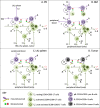Mitigating the risk of cytokine release syndrome in a Phase I trial of CD20/CD3 bispecific antibody mosunetuzumab in NHL: impact of translational system modeling
- PMID: 32859946
- PMCID: PMC7455723
- DOI: 10.1038/s41540-020-00145-7
Mitigating the risk of cytokine release syndrome in a Phase I trial of CD20/CD3 bispecific antibody mosunetuzumab in NHL: impact of translational system modeling
Abstract
Mosunetuzumab, a T-cell dependent bispecific antibody that binds CD3 and CD20 to drive T-cell mediated B-cell killing, is currently being tested in non-Hodgkin lymphoma. However, potent immune stimulation with T-cell directed therapies poses the risk of cytokine release syndrome, potentially limiting dose and utility. To understand mechanisms behind safety and efficacy and explore safety mitigation strategies, we developed a novel mechanistic model of immune and antitumor responses to the T-cell bispecifics (mosunetuzumab and blinatumomab), including the dynamics of B- and T-lymphocytes in circulation, lymphoid tissues, and tumor. The model was developed and validated using mosunetuzumab nonclinical and blinatumomab clinical data. Simulations delineated mechanisms contributing to observed cell and cytokine (IL6) dynamics and predicted that initial step-fractionated dosing limits systemic T-cell activation and cytokine release without compromising tumor response. These results supported a change to a step-fractionated treatment schedule of mosunetuzumab in the ongoing Phase I clinical trial, enabling safer administration of higher doses.
Conflict of interest statement
I.H., K.G., E.S., C.-C.L., and S.R. are all employees of Genentech Inc.; L.L.S. was an employee of Genentech at the time the studies were conducted and is currently an employee at Harpoon Therapeutics. Y.-W.C. was an employee of Genentech at the time the studies were conducted and is currently an employee at Fate Therapeutics. Genentech has filed patent applications related to TDBs, and is currently conducting clinical studies of the molecule mosunetuzumab. Genentech holds no stake in the molecule blinatumomab, which is a clinically-approved molecule for the treatment of ALL. Investigators may request materials from Genentech by submitting a request form at
Figures






Similar articles
-
CD20×CD3 Bispecific Antibodies in B-NHL: A Review of Translational Science, Pharmacokinetics, Pharmacodynamics, and Dose Strategy in Clinical Research.Clin Transl Sci. 2025 Jun;18(6):e70250. doi: 10.1111/cts.70250. Clin Transl Sci. 2025. PMID: 40471801 Free PMC article. Review.
-
Dose-escalation part of Phase I study of single-agent mosunetuzumab in Japanese patients with relapsed/refractory B-cell non-Hodgkin lymphoma.Jpn J Clin Oncol. 2023 Oct 4;53(10):912-921. doi: 10.1093/jjco/hyad082. Jpn J Clin Oncol. 2023. PMID: 37486002 Free PMC article. Clinical Trial.
-
Systems-based digital twins to help characterize clinical dose-response and propose predictive biomarkers in a Phase I study of bispecific antibody, mosunetuzumab, in NHL.Clin Transl Sci. 2023 Jul;16(7):1134-1148. doi: 10.1111/cts.13501. Epub 2023 Mar 23. Clin Transl Sci. 2023. PMID: 36908269 Free PMC article. Clinical Trial.
-
Summary of a workshop on preclinical and translational safety assessment of CD3 bispecifics.J Immunotoxicol. 2020 Dec;17(1):67-85. doi: 10.1080/1547691X.2020.1729902. J Immunotoxicol. 2020. PMID: 32100588
-
Bispecific Antibodies for Non-Hodgkin Lymphoma Treatment.Curr Treat Options Oncol. 2022 Feb;23(2):155-170. doi: 10.1007/s11864-021-00925-1. Epub 2022 Feb 19. Curr Treat Options Oncol. 2022. PMID: 35182296 Review.
Cited by
-
The Evolving Role of Bispecific Antibodies in Diffuse Large B-Cell Lymphoma.J Pers Med. 2024 Jun 21;14(7):666. doi: 10.3390/jpm14070666. J Pers Med. 2024. PMID: 39063920 Free PMC article. Review.
-
A mechanistic quantitative systems pharmacology model platform for translational efficacy evaluation and checkpoint combination design of bispecific immuno-modulatory antibodies.Front Pharmacol. 2025 Apr 10;16:1571844. doi: 10.3389/fphar.2025.1571844. eCollection 2025. Front Pharmacol. 2025. PMID: 40276607 Free PMC article.
-
Design of orthogonal constant domain interfaces to aid proper heavy/light chain pairing of bispecific antibodies.MAbs. 2025 Dec;17(1):2479531. doi: 10.1080/19420862.2025.2479531. Epub 2025 Mar 24. MAbs. 2025. PMID: 40126074 Free PMC article.
-
Safety of COVID-19 mRNA Vaccines in Patients with Cancer Enrolled in Early-Phase Clinical Trials.Cancers (Basel). 2021 Nov 20;13(22):5829. doi: 10.3390/cancers13225829. Cancers (Basel). 2021. PMID: 34830983 Free PMC article.
-
An αvβ6-specific virotherapy expressing bispecific immune cell activators induces immune cell activation to mediate tumor cell death.Mol Ther Oncol. 2025 Jun 25;33(3):201017. doi: 10.1016/j.omton.2025.201017. eCollection 2025 Sep 18. Mol Ther Oncol. 2025. PMID: 40741595 Free PMC article.
References
-
- Hiddemann W, et al. Frontline therapy with rituximab added to the combination of cyclophosphamide, doxorubicin, vincristine, and prednisone (CHOP) significantly improves the outcome for patients with advanced-stage follicular lymphoma compared with therapy with CHOP alone: results of a prospective randomized study of the German Low-Grade Lymphoma Study Group. Blood. 2005;106:3725–3732. doi: 10.1182/blood-2005-01-0016. - DOI - PubMed
Publication types
MeSH terms
Substances
LinkOut - more resources
Full Text Sources
Other Literature Sources
Medical

